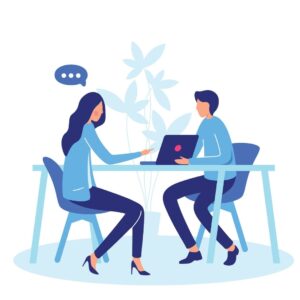Sales techniques vary from industry to industry. With all of the available strategies to employ, there are certain sales techniques that work best in particular situations. As such, the key for many sales reps is to find the sales technique that offers comfort and relative success and run with it every day.
However, subscribing to a particular niche sales technique is limiting even for the best salespeople. Sales techniques are not always exclusive to an industry, a customer persona or a target market. Being able to integrate timeless, universal sales strategies that work on a broad base will significantly increase your chances of closing.
Every sales professional can benefit from an understanding and appreciation of tried and true sales techniques. Have you ever watched a prospect walk out the door or waited forever for a return phone call only to wonder “what happened?” These tactics are crucial tools to avoid that kind of disappointment in the future.
Whether you are brand new to the sales game or a hardened veteran looking for a refresh, these sales techniques generate results for B2B and B2C sales professionals alike.
Best Sales Techniques
Focus on Your USP
As a salesperson, a vital sales methodology to use is directing the conversation to your unique selling proposition. What can you do better than the competition? How does that align with your prospect’s needs?
This often requires more qualifying, but discovering unconsidered needs elevates your solution above the competition. Take time to get a full understanding so that you can find areas that play to your strengths. Addressing those overlooked or unnoticed needs can also make you stand out from the competition because it gives a fresh perspective that can compel their decision-making.
It is crucial to remember one essential USP that any salesperson can leverage: themselves. Your honesty, knowledge, personality, effort and reliability all play into a customer’s decision to buy from you. Make the effort to connect, show genuine concern and exhaust the extent of your expertise to tailor solutions to the customer. There is lasting value in the impression you make throughout their experience.
Acknowledge the Competition
Many salespeople think that the best sales technique is to lower the competition and elevate your business. While this is not necessarily untrue, talking bad about the competition does little to preserve trust. Customers know you are trying to sell to them and putting down competitors plays directly into that mindset.
It is unnecessary to bring up the competition yourself. When the customer asks how you compare or asks about something they saw elsewhere, speak honestly and even be a little complimentary to your competition. Make an argument for your competitor’s solution, compare it to your solution and bring the conversation back to why you are the better choice.
Benefits, Not Features
Sales Techniques 101 teaches this simple yet easy-to-forget premise: Your customer is buying a solution, not a product. Selling a bunch of features does not solve the reason for them to seek out a product or service like yours.
Tap into the customer’s pain points and amplify them to get the customer to truly evaluate the cost of their status quo. Once you qualify your customer’s situation, asking them what does not work and what they are losing, you can sell solutions based on that.
Let’s say you run a digital marketing agency and you discover that your customer spends hours writing their own social media content. Show them the time they could be saving, the real benefit they could gain, with your professional service.
By selling to a benefit rather than a feature, you also make the power of “because” available to you. You can say something to the effect of “you should buy this product because it will be easier to do this.” This is by no means a guaranteed closing tool but it can be surprisingly impactful to drive your point home.
Prepare for Objections
Objections are inevitable when you are competing with other companies and the customer’s resistance to moving beyond the status quo. Whether it be B2B or B2C sales, customers are always trying to find reasons not to buy.
Think about the objections you hear time and time again. Rather than addressing them as they arise, taking a proactive approach to remove them during your sales presentation hastens the process. It is also an effective sales strategy because it communicates your experience and knowledge regarding their concern and an alignment of values.
Objections can also be used as a closing technique. Customers withhold their true feelings because of distrust, disinterest or even embarrassment and walk away from a sale because it stayed hidden. This is often the source of those “what happened?” moments that salespeople face.
Closing on the objection is a powerful tool that freezes customers against avoiding a purchase. As an example, if the customer says, “I need this delivered no later than Friday.” Ask them why that is vital and proceed with a follow up such as: “If I can get you this delivered on Friday, is there anything else that would stop you from making this decision today?” This can root out any additional underlying objections. Or, ideally, it puts them in a corner of sorts to make that final purchasing decision.
Stories: The Ultimate Sales Technique
As essential as you are to the sales team, so too should storytelling be essential in your presentation. Humans are natural storytellers and pitches framed in a storied structure resonate with customers.
Use stories in a variety of capacities to push your solution. Sales reps know that customers buy on emotion and justify with logic. A standard sales pitch caters primarily to logic: It makes sense to buy this product because you will get this benefit. While it is vital to speak to that technique for closing the sale, framing your pitch as a story captures your customer’s attention and stimulates action.
Storytelling affects individuals on a cognitive level because of its appeal to the emotional centers of the brain. A popular storytelling path is that of the “hero,” which in most cases would be the prospect. The customer can visualize themselves in the situation in which they or their business need a change.
They overcome obstacles to find a resolution (made possible through your guidance) and the story ends with them reaping the benefits of their transformation. Using this basic structure to discuss the advantages of your product or service makes your argument tangible and powerful.
Stories have numerous applications in the course of a sale and throughout your marketing in general. Stories are one of the best sales techniques because they help craft relevant testimonials, displaying either your product’s success or how missing out caused a downfall. It also reinforces information, making it easy to understand and relatable.
Try to create stories whenever you interact with prospects or current customers. They can be used in every conversation, whether you are talking about your company, your products or yourself. Stories are incredibly powerful in building a deep foundation of trust, motivating individuals and making their experiences positive and memorable.
Silence as a Sales Technique
Much like art, the white space around your interaction with a prospect is as essential to your sales efforts as the conversation. Salespeople have a tendency to fill in gaps of silence, finding them uncomfortable, uncertain and unproductive. However, using silence is an effective sales technique that gives you control of the situation and propels you to a close.
Staying silent as you develop thoughtful responses to customer questions helps build rapport. Being too quick to answer questions makes your response seem canned and dismissive. Take several seconds to formulate a response. It can feel like an eternity but it offers the chance to thoroughly address every component of the question.
More importantly, adding silence gives you, the salesperson, control of the conversation’s pace and direction, moving you closer to a sale.
As a sales technique, use silence to add emphasis to your key points, punctuating them so that your prospect has time to think about what you said. Doing so can also reveal the true objections when you ask questions, as customers may try to fill in awkward silences by providing more elaborate, useful information.
The critical point to remember is that, in most cases, silence should not be filled with more pitches. An uncomfortable silence filled by regurgitation of points you have already made can erode confidence and move you further away from a sale.
If everything has been covered, sales objections have been overcome and the customer appears to be trying to convince themselves, silence can indicate an opportunity to close. After a few seconds, ask something like “Shall I write this up for you?” or “When would you like this delivered?”. This can either close the sale immediately or reveal a deeper, significant objection.
CRM: The Perpetual Sales Technique

If you are not reaching out regularly to customers or following up on experiences, you are not creating value that would make you the first person to call when they need something later. With proper management, strong relationships with customers make your sales opportunities both more frequent and far easier to close.
Post-sale follow up is an essential component of an effective sales strategy. Inquiring how delivery went or how a new service is working opens doors to promote additional products or accessories. Further, qualify your customer and note opportunities for the future.
Regular follow up also shows that you are truly invested in your customer’s satisfaction with the product. Customers do not buy from a company but rather the salesperson and they often equate the two. You need to own that relationship by staying in contact about non-sales related items. Addressing problems they are experiencing or questions they have about a product imbues trust.
You do not have to be the one to necessarily solve your customer’s issues. But you can act as an agent on their behalf to facilitate resolution. Showing genuine concern, appreciation and dedication to helping in any capacity speak volumes about your integrity and value. Create a schedule with CRM software or a simple spreadsheet to follow up about new promotions or just to check-in.
And Finally, Stay Positive
If everybody bought from you 100 percent of the time, there would be no competition. This is not the reality for any business. Sales will be lost, customers will be disappointed, solutions will not work. It is a fact of life.
If you are doing everything you can to close sales and satisfy your customers, be proud of that. Do not let pessimism take control of your interactions with customers. It will degrade their confidence and yours and you will lose sales.
As a salesperson, you need to approach every customer with a fresh outlook. A bad experience with a customer should never carry over to a new prospect. You have solutions, build a mutually beneficial relationship, close the sale and satisfy your customer. Approach every sale, as well as every interaction before and after the sale, with confidence and project positivity throughout.
Key Takeaways from the Mentioned Sales Techniques
- Sell to your product or service’s specific benefits rather than features.
- Do not be afraid of silence. Use it to your advantage to control the conversation, make your customer consider their options and build rapport.
- Integrate potential objections organically into your sales pitch before the customer voices them.
- Own your CRM and interact frequently with customers, whether they have bought or not.
- Focus on your unique value and maintain optimism throughout your interactions.



